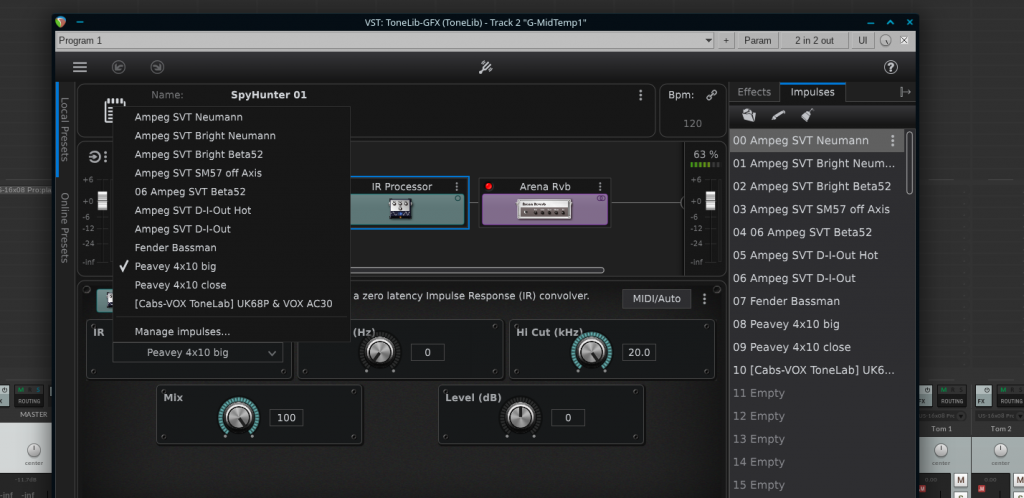*Updated 10/15/2022 to include Linux Studio Plugins.
When I took a serious interest in recording instruments, I began hearing about something called IR’s and had to dig to find out what they were. I was a late bloomer it seems.
IR stands for Impulse Response. Essentially an IR is a recording of a sound (like a guitar) played though a speaker (cabinet) in a environment (ie: studio live room) through a specific microphone. The final recorded file is just a wav or an aif with wav being much more common.
You load up your IR file into an impulse response loader, which is added to a track that contains a DI guitar and an amp sim of some sort, and the IR mimics the sound of the cab/microphone/room that was recorded.
IR’s are a must have if you’re using straight up amp sims on your guitar tracks. Normally amp sims on their own don’t sound super great; they’re very dry and don’t have a ton of “character”. Stick an IR of, for example, a Fender Tweed Champ 58 on the track and you’ll notice a big difference right away.
IRs can also be used for reverb. Similar to the idea of capturing a sound of specific amp/mics/rooms, reverb impulses capture the ambiance of specific places be it a famous concert hall, the space under a bridge, or even a school hallway.
While there are a ton of IR loaders out there, both paid and free and, as with everything else, a good percentage of them are for Windows and/or Mac.1
Fret not as there are Linux options, and they’re damn good.
Reaper supports IRs via its ReaVerb plugin and is pretty decent. I’ve been testing it out on a piece I’m working on and it seems to handle the job very well, as is pretty much expected from Reaper itself.

There is also the Linux Studio Plugins Impulse Responses and Impulse Reverb plugins. There is a mono and stereo version of each and they offer a little more tweaking capability than ReaVerb. I just started playing with these in Mixbus and so far so good.

The only issue I found with LSP is that it only supports wav. If you manage to find IRs that were created in aif, you’ll need to convert them using something like soundKonverter.
As an alternative to pure IR loaders, ToneLib GFX has an Impulse engine that allows you to add IRs directly into your amp/effects chain.

As for the IR files themselves, I have a pretty sizable IR library thanks to a few free packs:
-
-
- 7 Deadly Sins Impulse Pack. Absolutely huge amount of IR’s to go through. If you can think of a guitar cab, it’s probably here. I haven’t even scratched the surface of these.
- Studio Nord Bremen. A good handful of really well done IR’s covering all the greats: Marshall, Ampeg, etc as well as a few very decent reverbs.
- EchoThief. Reverb IRs taken from real spaces across North America.
- Housecall – Lexicon 480L: A set of reverb IRs based on the Lexicon 480L. (Note: These are aif files and may not work in some IR loaders. You may need to convert them to wav depending on their use.)
-
You can also find both free and paid IR’s just by searching online. The IR files themselves are platform agnostic, so go nuts.
Is using IR’s cheating? No it’s not and don’t let anyone tell you any different.
Of course there are purists out there who think we should only be recording guitars through actual amps in actual good sounding rooms using actual microphones. While most of us would love a room of amps, cabs, and mics at our disposal, it’s important to note that most of us don’t have the money, or the space for that much gear.
For us regular people who want a great sound without breaking the bank, IR’s come in very handy for shaping guitar tones.
1: Have a gander at this list. Lots of good shit, but try and find anything that supports Linux.
